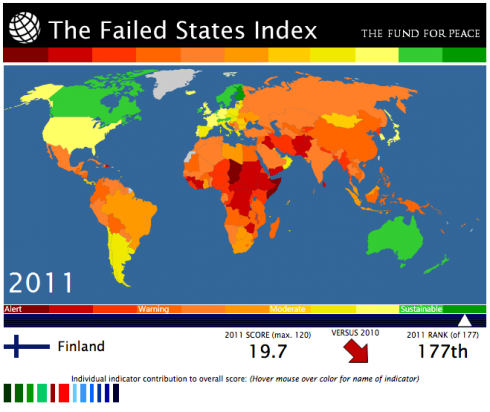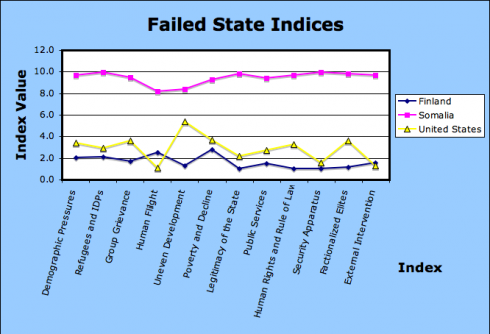The Fund for Peace has been doing a lot of thinking about what it takes for a country to be considered peaceful, and what it takes for a state to fail. For the last seven years they’ve been putting together maps of the world with an index of how stable different countries are.

While it’s pretty in-depth and makes for rather sobering reading, it’s worth taking a look at the criteria they’ve come up with to determine a country’s stability. It may be useful to include some of this information in the cycle where we focus on peace.
Their criteria for instability include:
- Demographic pressure (such as having too many young adults, as we’ve seen in Egypt)
- Amount of refugees and internally displaced peoples (refugees are people who’ve crossed international borders). Both leaving or entering refugees can undermine stability.
- Historical Injustice – communities can have an understandably hard time forgetting the past, just look at Isreal/Palestine.
- Brain Drain – when countries start to fail, the first to leave are the ones who can afford to. Yet these intellectuals and professionals, with their college degree are vital for creating a stable and prosperous country.
- Inequality – especially when driven by active discrimination (wealth inequality is something to watch out for).
- Economic decline – pushes trade into the black market and increases criminality and corruption.
- Illegitimacy of the state – if people don’t believe the people in government have everyone in the country’s best interests at heart, and are only looking out for themselves and their friends, then there’s probably going to be trouble.
- Public Services go kaput – It’s a really bad sign when the government can meet people’s basic needs – like picking up the garbage.
- The Rule of Law goes kaput – when you’re ruled by the caprice of men, and your rights under the law are not respected, you may begin to consider and agitate for other options for government.
- Personal Armies – forces that are tied to individual leaders, like private militias or super-secret police for example, are very damaging to a country’s cohesion.
- Fighting elites – healthy countries need robust arguments in their political class – think checks and balances – but it can go too far and lead to things like extreme nationalism and ethnic cleansing.
- Invasion – both overt invasion and covert meddling in the affairs of a country are unhealthy for that state’s stability.
It’s also very nice that you can download their index data as a MS Excel spreadsheet, which you can let students analyze to answer their own research questions. For example, I was wondering what was the difference between the best, the worst and the USA, so I plotted this graph.

The USA is much closer to Finland than Somalia, thank goodness, but should probably watch out for that Uneven Development (wealth inequality).
I think something like this would make a good experiential exercise for the science of geography.